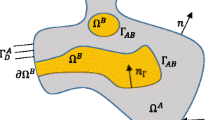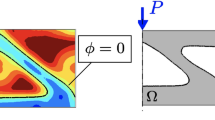Abstract
In topology optimization of a continuum, it is important to consider stress-related objective or constraints, from both theoretical and application perspectives. It is known that the problem is challenging. Although remarkable achievements have been made with the SIMP (Solid Isotropic Material with Penalization) framework, a number of critical issues are yet to be fully resolved. In the paper, we present an approach of a shape equilibrium constraint strategy with the level-set/X-FEM framework. We formulate the topology optimization problem under (spatially-distributed) stress constraints into a shape equilibrium problem of active stress constraint. This formulation allows us to effectively handle the stress constraint, and the intrinsic non-differentiability introduced by local stress constraints is removed. The optimization problem is made into one of continuous shape-sensitivity and it is solved by evolving a coherent interface of the shape equilibrium concurrently with shape variation in the structural boundary during a level-set evolution process. Several numerical examples in two dimensions are provided as a benchmark test of the proposed shape equilibrium constraint strategy for minimum-weight and fully-stressed designs and for designs with stress constraint satisfaction.















Similar content being viewed by others
References
Achtziger W, Kanzow C (2008) Mathematical programs with vanishing constraints: optimality conditions and constraint qualifications. Math Program 114:69–99
Allaire G, Jouve F (2008) Minimum stress optimal design with the level set method. Eng Anal Bound Elem 32:909–918
Allaire G, Jouve F, Toader AM (2004) Structural optimization using sensitivity analysis and a level-set method. J Comput Phys 194:363–393
Belytschko T, Xiao SP, Parimi C (2003) Topology optimization with implicit functions and regularization. Int J Numer Methods Eng 57:1177–1196
Bendsoe MP, Kikuchi N (1988) Generating optimal topologies in structural design using a homogenization method. Comput Methods Appl Mech Eng 71:197–224
Bendsoe MP, Sigmund O (2003) Topology optimization: theory, methods and applications. Springer, Berlin
Bruggi M (2008) On an alternative approach to stress constraints relaxation in topology optimization. Struct Multidisc Optim 36:125–141
Bruggi M, Venini P (2008) A mixed FEM approach to stress-constrained topology optimization. Int J Numer Methods Eng 73:1693–1714
Cheng GD, Guo X (1997) ϵ-relaxed approach in structural topology optimization. Struct Optim 13:258–266
Cheng GD, Jiang Z (1992) Study on topology optimization with stress constraint. Eng Optim 20:129–148
Choi KK, Kim NH (2005) Structural sensitivity analysis and optimization. Springer, New York
Duysinx P, Bendsoe MP (1998) Topology optimization of continuum structures with local stress constraints. Int J Numer Methods Eng 43:1453–1478
Duysinx P, Van Miegroet L, Lemaire E, Brüls O, Bruyneel M (2008) Topology and generalized shape optimization: why stress constraints are so important? Int J Simul Multidisc Des Optim 2:253–258
Eschenauer HA, Olhoff N (2001) Topology optimization of continuum structures: a review. Appl Mech Rev 54:331–390
Guo X, Zhang WS, Wang MY, Wei P (2011) Stress-related topology optimization via level set approach. Comput Methods Appl Mech Eng 200:3439–3452
Haftka RT, Gurdal Z (1992) Elements of structural optimization, 3rd edn. Kluwer, Boston
Haug EJ, Choi KK, Komkov V (1986) Design sensitivity analysis of structural systems. Academic Press, Orlando
Kang KS, Park GJ, Arora JS (2006) A review of optimization of structures subjected to transient loads. Struct Multidisc Optim 31:81–95
Kimia BB, Tannenbaum AR, Zucker SW (1995) Shape, shock, and deformations I: the components of two-dimensional shape and reaction-diffusion space. Int J Comput Vis 15:189–224
Kirsch U (1990) On singular topologies in optimum structural design. Struct Optim 2:133–142
Kristensen ES, Madsen NF (1976) On the optimum shape of fillets in plates subjected to multiple in-plane loading cases. Int J Numer Methods Eng 10:1007–1019
Le C, Norato J, Bruns T, Ha C, Tortorelli D (2010) Stress-based topology optimization for continua. Struct Multidisc Optim 41:605–620
Lipton R, Stuebner M (2006) Optimization of composite structures subject to local stress constraints. Comput Methods Appl Mech Eng 196:66–75
Nocedal J, Wright SJ (1999) Numerical optimization. Springer, New York
Osher S, Fedkiw R (2002) Level set methods and dynamic implicit surfaces. Springer, New York
Osher S, Sethian JA (1988) Front propagating with curvature-dependent speed: Algorithms based on Hamilton-Jacobi formulations. J Comput Phys 79:12–49
París J, Navarrina F, Colominas I, Casteleiro M (2009) Topology optimization of structures with local and global stress constraints. Struct Multidisc Optim 39:419–437
Pedersen P (2000) On optimal shapes in materials and structures. Struct Multidisc Optim 19:169–182
Pedersen P, Laursen CL (1982) Design for minimum stress concentration by finite elements and linear programming. Struct Eng Mech 10:375–391
Pereira JT, Fancello EA, Barcellos CS (2004) Topology optimization of continuum structures with material failure constraints. Struct Multidisc Optim 26:50–66
Poon NMK, Martins JRRA (2007) An adaptive approach to constraint aggregation using adjoint sensitivity analysis. Struct Multidisc Optim 34:61–73
Rozavany GIN, Birker T (1994) On singular topologies in exact layout optimization. Struct Optim 8:225–232
Rozvany G (2001a) Aims, scope, methods, history and unified terminology of computer aided topology optimization in structural mechanics. Struct Multidisc Optim 21:90–108
Rozvany GIN (2001b) On design dependent constraints and singular topologies. Struct Multidisc Optim 21:164–172
Sokolowski J, Zolesio JP (1992) Introduction to shape optimization: shape sensitivity analysis. Springer, New York
Sukumar N, Moes N, Moran B, Belytschko T (2000) Extended finite element method for three-dimensional crack modelling. Int J Numer Methods Eng 48:1549–1570
Sukumar N, Chopp DL, Moes N, Belytschko T (2001) Modeling holes and inclusions by level sets in the extended finite-element method. Comput Methods Appl Mech Eng 190:6183–6200
Svanberg K, Werme KM (2007) Sequential integer programming methods for stress constrained topology optimization. Struct Multidisc Optim 34:277–299
Van Miegroet L, Duysinx P (2007) Stress concentration minimization of 2D filets using XFEM and level set description. Struct Multidisc Optim 33:425–438
Wang MY, Wang XM, Guo DM (2003) A level set method for structural topology optimization. Comput Methods Appl Mech Eng 192:227–246
Wei P, Wang MY, Xing XH (2010) A study on X-FEM in continuum structural optimization using a level set model. Comput Aided Des 42:708–719
Xia Q, Shi T, Liu S, Wang MY (2012) A level set solution to the stress-based structural shape and topology optimization. Comput Struct 90–91(1):55–64
Yang RJ, Chen CJ (1996) Stress-based topology optimization. Struct Multidisc Optim 12:98–105
Acknowledgments
The financial support from the Research Grants Council of Hong Kong S.A.R. (project No. CUHK417309) is gratefully acknowledged. The author would like to thank Drs. Qi Xia and Zhen Luo for their valuable discussions on the related topics.
Author information
Authors and Affiliations
Corresponding author
Rights and permissions
About this article
Cite this article
Wang, M.Y., Li, L. Shape equilibrium constraint: a strategy for stress-constrained structural topology optimization. Struct Multidisc Optim 47, 335–352 (2013). https://doi.org/10.1007/s00158-012-0846-9
Received:
Revised:
Accepted:
Published:
Issue Date:
DOI: https://doi.org/10.1007/s00158-012-0846-9




